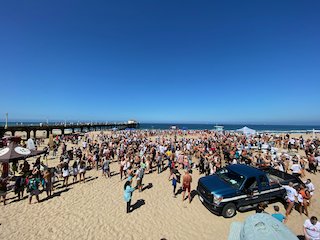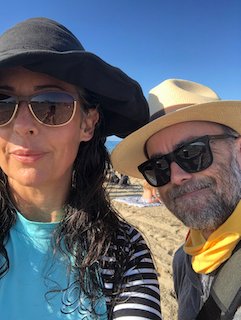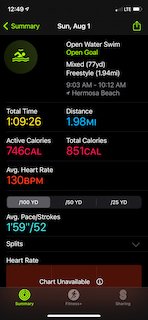On Nine Years of Daily C Shots
Hello and Happy Holidays from f*cking freezing San Francisco!
Me and the Bloomgindale’s brown bear in San Francisco.
I'm too busy with life to blog right now, but this milestone deserved a post.
This December marks nine years of doing daily intramuscular injections of vitamin C (ascorbic acid), currently prescribed as Ascor, which is FDA approved for the treatment of scurvy but I use it for Hypermobility Ehlers-Danlos Syndrome.
This intervention supports the health of my collagen and has alleviated most of my symptoms. The C shots have made it possible for other treatments actually to work. Before that, I was hopelessly stuck in the pain–fatigue cycle. No matter what I tried, I could improve. I spent years of my life with zero energy, in unlivable pain, and never improving. It was awful.
Now, I have a quality of life beyond my wildest dreams. It is not that my EDS is cured — it is managed. It no longer takes me down. I still have some version of my old problems, to some light extent. They flare up very little. I'm not a normal person, but I'm close. And yes, I'm still very flexible, which makes the name of my blog ironic. I love irony.
Here’s my medical current regimen.
AppleFitness+
I got this during the pandemic when my gym closed for good. I have been strength training (lifting weights) like never before. I'm sure that has helped me even more. A body like mine is stabilized best by its own muscles. Lifting also reduces pain sensitivity in the body. Gregggggg Cook is my favorite! He shows complex moves that get the spine stabilized. Makes my back feel so good.
Blood Flow Restriction Training
I got BFRT cuffs and did the Smart Cuffs training. Blood Flow Restriction Therapy is weights or light cardio done with tourniquets on, which causes a cascade of healing and muscle growth. The areas that heal are distal to (downstream of) the cuffs. The cuffs are placed on your upper arms or upper thighs, never upper and lower at the same time. BFRT heals tendons, ligaments, and bones in elbows, wrists, knees, feet. The cuffs cause rapid muscle development. BFRT also conditions the cardiovascular system. Find a physical therapist with a set!
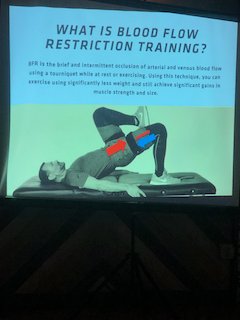
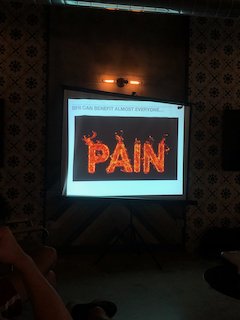
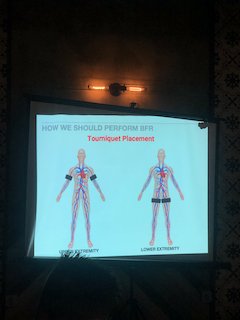

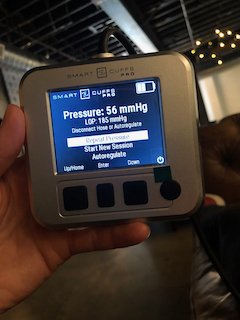
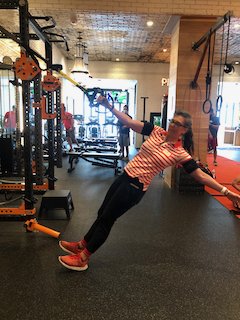
Circulation
Is the other greatest intervention. The more cardio I do, the fewer POTS symptoms I have. I rarely get dizzy or fainty anymore, and my energy is consistent throughout the day. No crashes. And while we’re on that subject . . .
Postural Orthostatic Tachycardia Syndrome
On the subject of POTS, I did a few years of salt-loading — adding it to all the water I drank and dumping it on my food. It made me feel so much better by raising my blood volume and blood pressure.
My new endocrinologist encouraged me to reduce my salt intake because she thinks that high salt can weaken bones. I have read the opposite, but okay, I did reduce my salt intake.
You know what? My thirst is much less than it used to be. For most of my life, it was painfully excessive. Salt loading raises your own production of vasopressin, which makes your body better regulate fluid in your brain. Oh, that feels nice. See this PubMed Salt-loading increases vasopressin.
Drugs that Reduce Pain Sensitivity
Ketamine
I got 24 ketamine infusions over one year. For the last 12, I did one infusion per week, the closest in succession I ever did them. (I spread them out because they take so much time, and I hate them.)
Altogether, they made my head and neck stop blowing up, which I'm almost afraid to say out loud because I don't want to jinx it.
During this time, I started working with another physical therapist who addressed my core in entirely new ways. Wow, did I need that. That may also be why my neck is not so angry at the world.
I’m not going to do any more ketamine for a while as the long-term effects are not known.
The GLP-1 Agonist
In my desperation to stay as pain-free as possible, I went on a very low dose of a GLP-1 agonist. See this Pub Med Activation of Spinal Glucagon-Like Peptide-1 Receptors Specifically Suppresses Pain Hypersensitivity.
"For the first time, we demonstrate that exogenous exenatide and GLP-1, by activation of spinal dorsal horn GLP-1Rs, effectively block broad pain hypersensitivity states without affecting acute nociceptive reflex behaviors. "
Nice!!
This drug also seems to have improved my body's energy regulation. And my mood. See PubMed Alleviation of Depression by Glucagon-Like Peptide 1 Through the Regulation of Neuroinflammation, Neurotransmitters, Neurogenesis, and Synaptic Function.
When a drug helps the brain, it can really help the brain.
I am taking is Ozempic. It is approved as a weight-loss drug, so my insurance will not pay for it for me. You can get it much cheaper if your doctor sends a prescription to a pharmacy in Canada.
I am on the dose of three pen clicks every ten days. This dose is so tiny, this pen will last me many, many months. The pen says to discard after 56 days. I have a friend who used to rep this drug for Novo Novartis. She told me I could keep using it beyond that.
The first GLP-1 agonist I tried was Victoza, but it bothered my digestion too much. There are other GLP-1 agonists. I would be curious to try them if I could get a sample pen sometime.
Metformin
is another drug that seems to reduce pain sensitivity by acting on the glial cells in the nervous system. See this article Ketamine and Metformin by Forest Tennant.
Metformin also seems to eat up arthritic damaging joints. See Exploration of metformin as novel therapy for osteoarthritis: preventing cartilage degeneration and reducing pain behavior. It is also neuro-protective — good for brain health.
My understanding is that Metformin activates pathways that get activated when you fast, which clean up damaged cells. So, like fasting, you lose muscle mass if you do it too much. That happens with Metformin also. I cycle on and off of it just to give my body a break. I'm not sure what schedule is best.
I could not tolerate the oral pill because of the digestive side effects, so I got a compounded cream. It is so well-absorbed in the skin that you only need one 10th of the dose. Nice!
Low Dose Naltrexone
LDN is a great pain de-sensitizer and health enhancer. I dissolve the big pills in 50 mls of water and take a tablespoon, about 4.5 mg every morning. My insurance will pay for the manufactured pills, not compounded ones. I like to save my money for fun things not medical care, when I can.
I also like 25 g or 50 mg of naltrexone for insomnia, nighttime anxiety, or severe pain. It seems to push my brain through the pain and make me relax.
Bone Health
Long ago when I was diagnosed, the Ehlers-Danlos National Foundation was our advocacy group. They said that early osteoarthritis and osteoporosis are significant complications of EDS. However, I don't hear much about bone density anymore, which is a shame. Fractures can be devastating. Unfortunately, a lot of drugs that we are put on (steroids, opioids, proton pump inhibitors, some ADD meds, and some antidepressants) weaken bones.
Since I was diagnosed, I have been getting DEXAs and x-rays of all my joints every two years. I watch my bone density come and go based on my activity level.
Here is what I take for my bones.
Testosterone. I'm injecting 100 milligrams per month, divided into two or four doses. It's fantastic. Great for building muscle and having more endurance.
I am on DHEA, which makes me feel great. I had to start on 1 mg. Now I do about 4 mg. It takes a long time for my body to get used to something. I think the DHEA remedies the stress-pain-burnout from so many years of EDS torture.
Other supplements I take are primarily for my bone health: trace minerals, evening primrose oil, vitamin K-1, vitamin D 5000 IUs, and l-carnitine on an empty stomach.
I take supplements other day or every two days except for the vitamin D, which I never skip. Why? They get expensive. Who knows how safe they really are. But we know Vitamin D is health enhancing.
I take Microzide every day to help keep calcium in my bones. See Low-dose hydrochlorothiazide and preservation of bone mineral density.
I take a combination of proline + lysine OR n-acetyl cysteine + methionine on an empty stomach when I remember, which is not all that often. Not all together because they compete for absorption. They support collagen, and NAC+methionine are powerful antioxidants.
I also take arginine and glycine at night on an empty stomach to promote healing and restful sleep. I tend to get heartburn. Arginine and glycine seem to heal the esophagus, so that sounds like it's worth my time. See Orally administered L-arginine and glycine are highly effective against acid reflux esophagitis. I probably have a hiatal hernia. I have an endoscopy scheduled and am sure looking forward to it.
Thoughts on EDS
EDS is a disease that creates many difficult to describe symptoms.
I would list them as
extreme fatigue/exhaustion not relieved by rest
extreme hypersensitivity in every way
extreme pain sensitivity
extreme anxiety
brain overload
low cognition
severe head/neck pain
digestive problems
stress rashes
sleep disturbances
and of course loose joints
Does this list sound silly? These are so debilitating, it's unbelievable.
I don't have a lot of this anymore. I get up every day, and I keep going. My body is just a little extra sensitive. I’m religious about taking care of myself — food, sleep and exercise. I must be. I cannot do whatever I want and take being able to function for granted. That's for normal people and good for them.
Sleep Well!
For sleep issues, I highly recommend googling sleep hygiene or seeing a therapist who does Cognitive Behavioral Therapy for sleep. This is not like regular CBT, which tells you how dumb you are to believe your thoughts. No, this Sleep CBT teaches you procedures to train your body to sleep. Sleep is a conditioned response to a large extent, like Pavlov's dogs who learned to salivate when Pavlov rang a bell because he always did that before he fed them.
With sleep, for one thing, don't watch TV or read in bed. Your body will get confused about where and when to sleep.
Eat to Support Digestion and Circadian Rhythms
A book that has benefited me a lot that I have neglected to talk about is by a neuroendocrinologist. Who knew there was such a speciality?
This eating pattern supports the healing that should be occurring at night and absorption of nutrients, which happens best during the morning. It's made another nice difference in my life. I also digest best with this pattern.
Who comes up with ideas for treating me ?
Me!
Some people get up and meditate in the morning.
Some people get up and read the Bible.
I start my day reading the latest medical research. That's where I read about the marvelous class of drugs, the GLP-1 agonist.
Starting my day this way makes me feel empowered and hopeful, optimistic about my health. It amps me up to get anything done.
I've been doing this for so long. That's how we stumbled on the C shots, down at the public library, many years ago when I was reading everything, looking for clues to me. My symptoms are a lot like a scurvy victim's.
I have two doctors on my team that are willing to read research and consider prescribing anything. That's the sort of stuff you must do when you have a complex disease that is not understood and has no treatment protocol. My medical relationship are everything to me. I try to make the doctor my friend, by being polite and understanding, and showing care in return. The doctor's office is not the place to vent my frustration about my disability. That's for Facebook groups, where you can find a celebration of negativity. Venting has its place but may not be the best use of your limited energy.
On Chasing Cures
Have you read
An essay called "I'm Tired of Chasing a Cure" by Liz Moore makes some great points about what can happen when you are throwing yourself at anything, chasing cures. She exhausted herself and almost died from Lyme disease treatment that seemed to work for a while then stopped working. So did she even really have Lyme? Who knows. She decided acceptance was a better route to go.
It's important to accept your disability. Then make decisions based on the best advice and medical understanding of your disease. Unfortunately EDS is not well-understood. But at least we know something! It all starts with getting a correct diagnosis. Wrong diagnosis = wrong treatment = possibly getting worse. Note: a diagnosis can change as scientific understanding advances.
On Surgery
I question the benefits of surgery for the EDS body.
I believe EDS is primarily a pain disease. Pain occurs in the brain. Whatever is going wrong with our collagen primes our body to plunge into that pain endless pain-feedback cycle, which induces fatigue and cognitive decline. Naturally, surgery can amplify this because it hurts and causes damage. Also, there are limits to what surgery can do when all your collagen is flimsy. Make surgical decisions with great care.
Mostly, I see surgery leading to more surgery and in the same area on an EDSer. Why not do 13 shoulder surgeries if the first 12 failed?
I rarely see an EDSer having a joint surgery that leads to a higher quality of life. That's because we lack quality of life due to our extreme sensitive, pain overload and exhaustion, not because we have one shoulder injury. Is it even injured or does it hurt because pain feedback has gone haywire?
I have avoided joint surgeries except for my foot. After I broke severely, it seemed time to reconstruct it. So I did.
Nobody does chemo because they like it.
My experience with EDS is that it takes correct posture correction and as much strength as you can get to stabilize yourself. That’s not the easiest thing for a doctor to say to an EDS patient who is in agony. But I can say it because I was that patient in too much pain to pick up a paperclip.
It's very hard to get going on moving when you are weak, never mind when you have EDS on top of that. It can seem impossible. I never got anywhere without daily C shots, so for me it was impossible.
Oh, and avoid unnecessary stretching because that's moving in the opposite direction.
The stretchier a muscle is, the less power it can generate.
That simple stuff any fitness trainer would know. But a lot of doctors don’t know anything about fitness.
Happy Holidays!
Here I am at the 2021 Dwight Crum Pier-to-Pier which I forgot to post about.
It was a difficult swim. I was so tired from my ketamine infusions. But I made a decent time and avoided the great whites. Yay!
